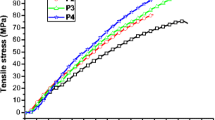Summary
Effects of drawing on molecular motions in amorphous poly(ethylene terephthalate) (PET) were studied by the dielectric relaxation measurements. The rate of the segmental motion increases by small drawing and turns to decrease with draw ratio in large draw ratios. The local mode relaxation time in glassy PET was found to vary with draw ratio in a more complex manner than the segmental mobility does. These variations of molecular motions are explained in terms of the free volume in PET. A structural model for the drawn PET is postulated from the evidences on the variations of the density, the birefringence and the dielectric properties with the draw ratio. That is, the small drawing promotes the molecular orientation more or less but produces unstable chain conformations accompanied with a local volume increase, while the high drawing enhances the molecular aligment.
Zusammenfassung
Einfluß von Verstreckung auf die molekulare Bewegung in amorphem Polyäthylenterephthalat (PET) wurde mittels der dielektrischen Relaxationsmethode untersucht. Die Geschwindigkeit der segmentförmigen Bewegung nimmt mit schwacher Verstreckung zu, jedoch mit starker Verstreckung ab. Für die Relaxationszeit der lokalen Mode in glasigem PET wurde gefunden, daß sie sich mit dem Verstreckverhältnis komplizierter ändert als die segmentförmige Mobilität. Diese Variationen der molekularen Bewegungen werden durch den Begriff des freien Volumens erklärt. Ein Modell des verstreckten PET wird aus den Nachweisen der mit dem Verstreckverhältnis geänderten Dichte, der Doppelbrechung und der dielektrischen Eigenschaften erschlossen. Nämlich: eine geringe Verstreckung fördert mehr oder weniger die molekulare Orientierung, ruft jedoch eine von der lokalen Volumenvergrößerung begleitete unbeständige Kettenanordnung hervor, während eine starke Verstreckung die molekulare Ordnung erhöht.
Similar content being viewed by others
References
Saito, S., H. Sasabe, T. Nakajima, andK. Yada, J. Polym. Sci. A-2,6, 1297 (1968).
Yamafuji, K. andY. Ishida, Kolloid-Z.183, 15 (1962).
Cohen, M. H. andD. Turnbull, J. Chem. Phys.31, 1164 (1959). -Williams, M. L., R. F. Landel,andJ. D. Ferry, J. Amer. Chem. Soc.77, 3701 (1955).
Adam, G. andJ. H. Gibbs, J. Chem. Phys.43, 139 (1965).
Ito, E. andS. Okajima, Nippon Kagaku-kaishi1, 142 (1972).
Robertson, R. E., J. Chem. Phys.44, 3950 (1966).
Vieth, W. R., E. S. Matulevicius, andS. R. Mitchell, Kolloid-Z. u. Z. Polymere220, 49 (1967).
Okano, K., Rept. Inst. Phys. Chem. Research (in Japanese)40, 273 (1964).
Author information
Authors and Affiliations
Rights and permissions
About this article
Cite this article
Ito, E., Okajima, S., Sasabe, H. et al. Effects of drawing on molecular motions in poly(ethylene terephthalate). Kolloid-Z.u.Z.Polymere 251, 577–582 (1973). https://doi.org/10.1007/BF01498580
Received:
Issue Date:
DOI: https://doi.org/10.1007/BF01498580




